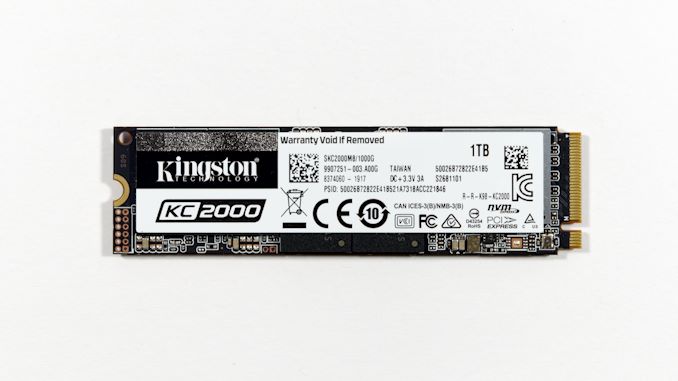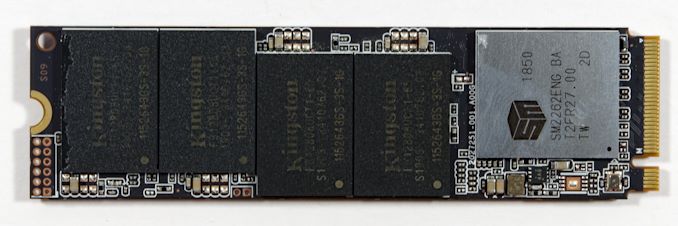The Kingston KC2000 SSD Review: Bringing BiCS4 To Retail
by Billy Tallis on July 22, 2019 8:00 AM EST
The Kingston KC2000 is a new high-end consumer M.2 NVMe SSD. Kingston had been neglecting this market segment for a while, but the two year old KC1000 has finally been replaced by a proper successor using the latest flash memory and controllers.
The SSD market is in the midst of two significant-but-protracted transitions. First off, PCIe 4.0 has arrived in one small corner of the market, but so far it offers little aside from increased power usage. Meanwhile the second transition is the move from 64-layer to 96-layer 3D NAND; this is a bit more widespread, but is still moving slowly. Toshiba started shipping their 96L NAND almost a year ago, but in the first half of 2019 we saw more new retail SSDs launch with 64L NAND than with 9xL NAND. Kingston's not the first to use 96-layer 3D TLC in a retail drive, but they're still generally ahead of the curve and have even beat Toshiba and Western Digital to market using their BiCS4 96L NAND.
The Kingston KC2000 illustrates a broader trend of diversification that we've been seeing signs of with this new generation of flash memory. SSD vendors that don't make their own controllers or NAND are exploring a wider range of options than in recent years. With 32-layer and 64-layer NAND, there was a strong association between Silicon Motion SSD controllers and Intel/Micron NAND, while at the same time Toshiba's 15nm and 64L NAND were mostly used with Phison SSD controllers. (Marvell's presence in the retail consumer SSD market has dropped significantly, and newer controller suppliers like Realtek haven't had much impact.) With the 96-layer generation, Silicon Motion and Phison are both fully supporting multiple NAND vendors, and SSD vendors are trying out the new options.
Kingston has been a fan of the Phison+Toshiba combinations for quite a while, but the KC2000 pairs Toshiba's 96L NAND with the Silicon Motion SM2262EN controller instead of the Phison E12 or E16 we would have predicted. That gives us the chance to make a very direct comparison between Micron 64L TLC and Toshiba 96L TLC, since we have tested several drives using the SM2262EN controller with the Micron NAND. We already have some idea how Toshiba's 96L NAND compares against their own previous generation thanks to our testing of the XG5 and XG6, but those are OEM-only drives with performance constrained by a somewhat outdated controller. The Kingston KC2000 is one of the first drives to bring Toshiba's 96L NAND to the retail market, and it will be followed by many others over the next year.
| Kingston KC2000 SSD Specifications | ||||||
| Capacity | 250 GB | 500 GB | 1 TB | 2 TB | ||
| Form Factor | M.2 2280 PCIe 3.0 x4 | |||||
| Controller | Silicon Motion SM2262EN | |||||
| NAND Flash | Toshiba 96L BiCS4 3D TLC | |||||
| Sequential Read | 3.0 GB/s | 3.0 GB/s | 3.2 GB/s | 3.2 GB/s | ||
| Sequential Write | 1.1 GB/s | 2.0 GB/s | 2.2 GB/s | 2.2 GB/s | ||
| Random Read IOPS | 350k | 350k | 350k | 250k | ||
| Random Write IOPS | 200k | 250k | 275k | 250k | ||
| Power Consumption | 3 mW Idle, 2.1 W Max Read, 7 W Max Write | |||||
| Encryption | AES 256, TCG Opal 2.0, eDrive | |||||
| Warranty | 5 years | |||||
| Write Endurance | 150 TB 0.3 DWPD |
200 TB 0.3 DWPD |
600 TB 0.3 DWPD |
1200 TB 0.3 DWPD |
||
The Silicon Motion SM2262EN controller is a very familiar chip at this point, especially this late in the product cycle. It's a minor update over last year's SM2262 that mostly brings firmware optimizations for improved peak performance. When paired with Micron 64L NAND it has repeatedly proven capable of delivering very high performance for a drive with a PCIe 3 x4 interface., and it's unlikely to be the bottleneck when used with Toshiba's 96L NAND. Kingston's specs for the KC2000 agree: most of the performance ratings are a bit lower than the competition using Micron NAND. The power consumption specs suggest that we may see some of the impressive efficiency that Toshiba/WD BiCS NAND has been providing in first-party drives like the Toshiba XG series and the recent WD Black models.
The Kingston KC2000 lineup spans from 250GB to 2TB. That smallest capacity point has started to disappear from some flagship high-end product lines because it isn't able to deliver the same level of performance that larger models can. For the KC2000, Kingston is keeping the smallest and most affordable capacity around, but with significantly slower write speed ratings.
The 5-year warranty and 0.3 DWPD write endurance ratings for the KC2000 are standard for this market segment. The support for TCG Opal and eDrive encryption are still relatively uncommon among retail NVMe drives, and probably result from Kingston's strong focus on the business market.
Kingston uses a double-sided layout for the KC2000. The DRAM and NAND were binned and packaged by Kingston, and they generally prefer to use more packages with fewer dies each. This means we have eight total NAND packages of 128GB (1024Gb) each and two DRAM packages of 512MB each on our 1TB sample; a tight fit overall, especially compared to the loose spacing seen on previous SM2262EN drives.
The Competition
The most interesting comparison for the Kingston KC2000 is another drive using the same Silicon Motion SM2262EN controller. For this review, that role is filled by the ADATA SX8200 Pro. The Toshiba XG6 is the only other drive we have so far that uses Toshiba 96L TLC, but it's an OEM-only product. The Silicon Power P34A80 is the representative from the wide field of products that combine Toshiba's 64L TLC with the Phison E12 controller. Also from the Phison camp is Kingston's entry-level NVMe drive, the A1000 that uses the Phison E8 controller and Toshiba 64L TLC. We also include results for flagship drives from Intel, Samsung and Western Digital.
| AnandTech 2018 Consumer SSD Testbed | |
| CPU | Intel Xeon E3 1240 v5 |
| Motherboard | ASRock Fatal1ty E3V5 Performance Gaming/OC |
| Chipset | Intel C232 |
| Memory | 4x 8GB G.SKILL Ripjaws DDR4-2400 CL15 |
| Graphics | AMD Radeon HD 5450, 1920x1200@60Hz |
| Software | Windows 10 x64, version 1709 |
| Linux kernel version 4.14, fio version 3.6 | |
| Spectre/Meltdown microcode and OS patches current as of May 2018 | |
- Thanks to Intel for the Xeon E3 1240 v5 CPU
- Thanks to ASRock for the E3V5 Performance Gaming/OC
- Thanks to G.SKILL for the Ripjaws DDR4-2400 RAM
- Thanks to Corsair for the RM750 power supply, Carbide 200R case, and Hydro H60 CPU cooler
- Thanks to Quarch for the HD Programmable Power Module and accessories
- Thanks to StarTech for providing a RK2236BKF 22U rack cabinet.















29 Comments
View All Comments
LtGoonRush - Monday, July 22, 2019 - link
The Silicon Power P34A80 uses the same controller and NAND as the MP510, but with newer, better-performing firmware.Death666Angel - Monday, July 22, 2019 - link
Do they use custom FW or just stock Phison one? You can install 12.3 (which I think is the latest) stock Phison FW on the MP510.LtGoonRush - Monday, July 22, 2019 - link
It's stock Phison firmware, I thought Corsair didn't offer their own firmware updates for the MP510 (like many vendors) but I could be wrong. I know there's a method to flash the Phison reference firmware onto a reference drive, but I would only recommend that to the adventurous who don't mind wiping their drives.Death666Angel - Tuesday, July 23, 2019 - link
Oh, Corsair doesn't offer the newest FW by themselves, I was refering to the stock Phison one that you can flash. :) Haven't seen anyone report a brick so far and the only people who might get a wiped drive are updating from way early FW as far as I saw. But doing a FW update and not backing up is just asking for trouble, whether it be official or not.sandberg123 - Monday, August 5, 2019 - link
Actually, this will be faster than the 970 EVO in real life.Foeketijn - Monday, July 22, 2019 - link
If I were in the SSD R&D business and not working for SAMSUNG, I would be getting depressed by now.Alistair - Monday, July 22, 2019 - link
You must only be looking at The Destroyer? Too long and too read heavy? If you look at the Heavy test actually I think Adata is killing Samsung in overall performance for way less money. Just don't use the drive full that's all, easy enough to do when you can buy double the amount for the same price.TheUnhandledException - Tuesday, July 23, 2019 - link
If you have to keep the drive half empty to avoid losing performance then the effective price per usable GB is higher than the list price. I agree ADATA is a good value for the buck but I wouldn't say they are killing Samsung (or anyone else) in the heavy benchmark.Strikamos - Tuesday, July 23, 2019 - link
I'm planning on buying the Corsair MP510! Does it have the same problem as the ADATA? Loosing performance when full.. Thank youDeath666Angel - Tuesday, July 23, 2019 - link
Every consumer SSD ever loses some performance when 100% full. Some are better (overprovisioning from the factory, SLC, MLC, TLC, QLC, TRIM, garbage collection, write amplification, wear leveling etc.) than others. TLC with SLC caches (which is the norm and great bang/buck) have a smaller SLC cache the fuller the drive gets. 42GB at empty is a typical figure for 512/1TB drives I think and it gets smaller. Keeping 10% free was an often advised figure in the days of MLC and garbage collection routines. I'd stick to that or 50/100 GB depending on size. My 1 TB system SSD has between 50 and 150GB free and I don't want to go below 50GB free. Things have generally become much better and if you run consumer workloads you will hardly notice a difference going nearly full.